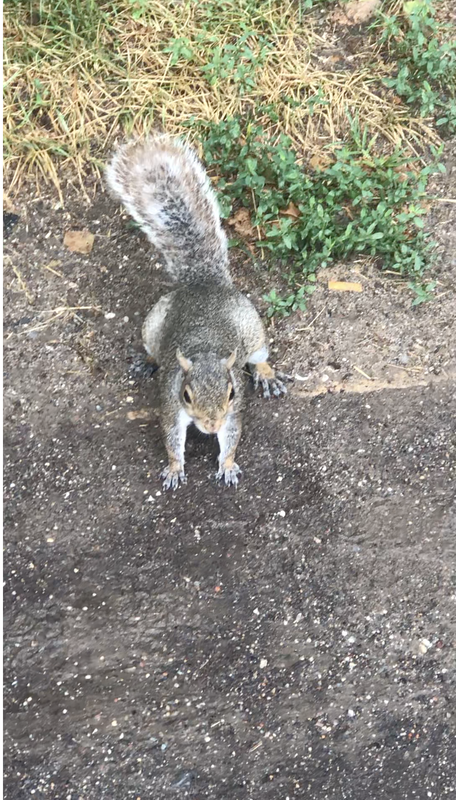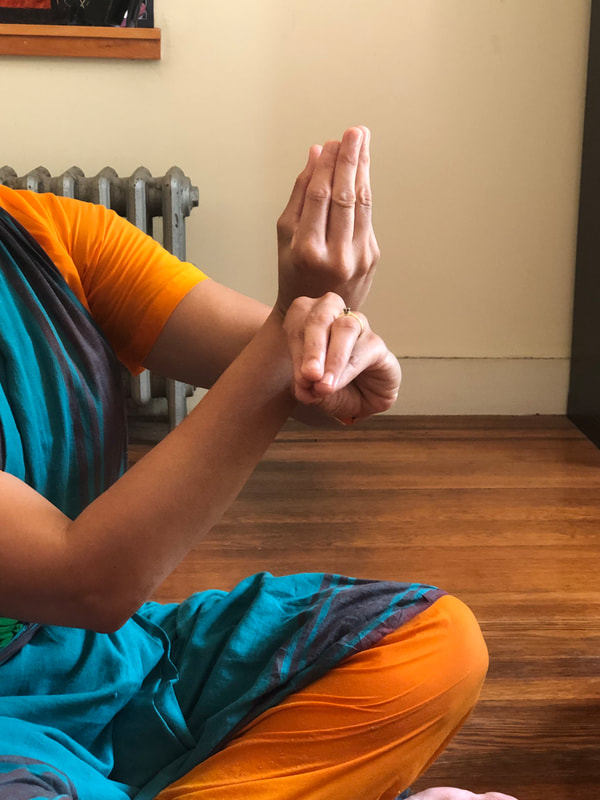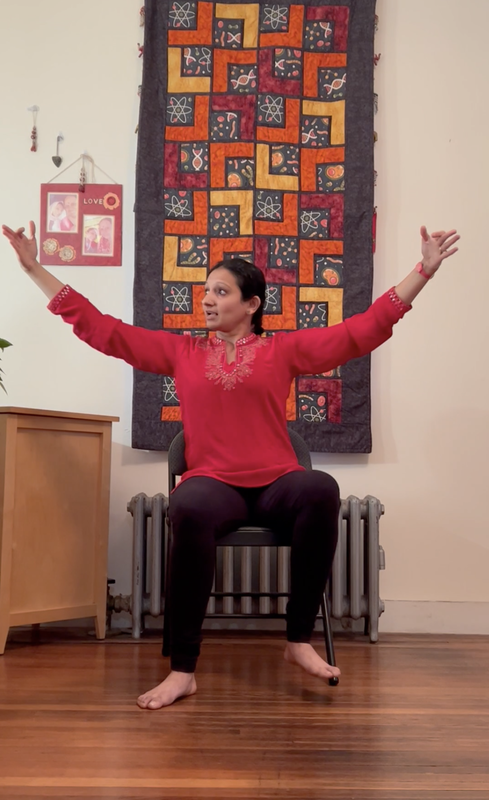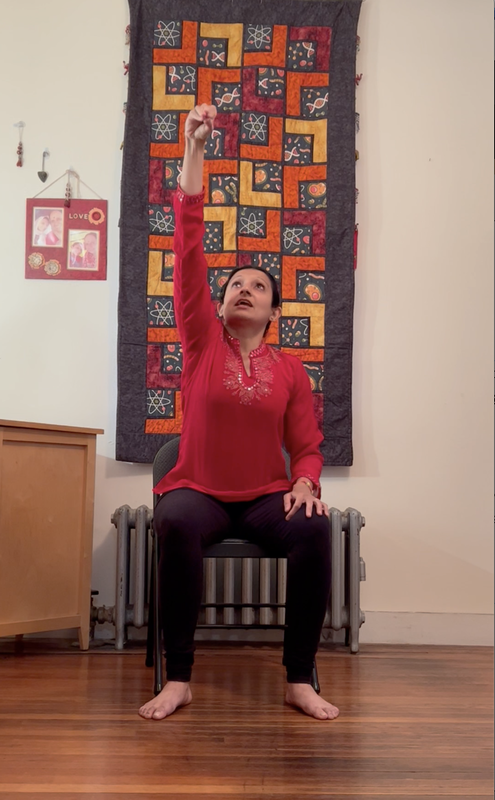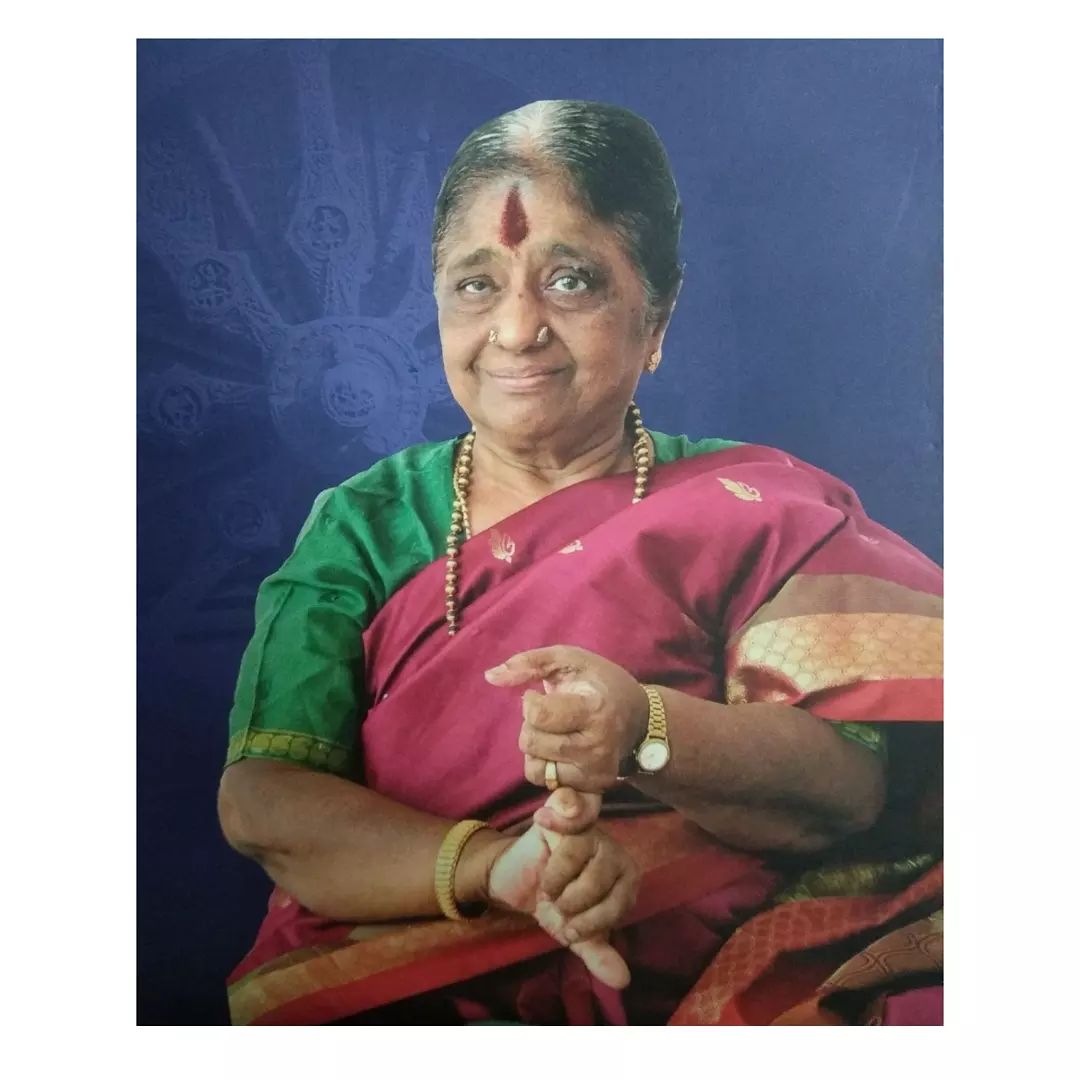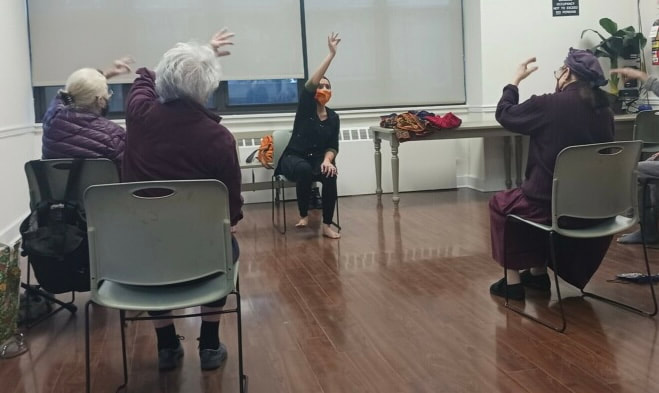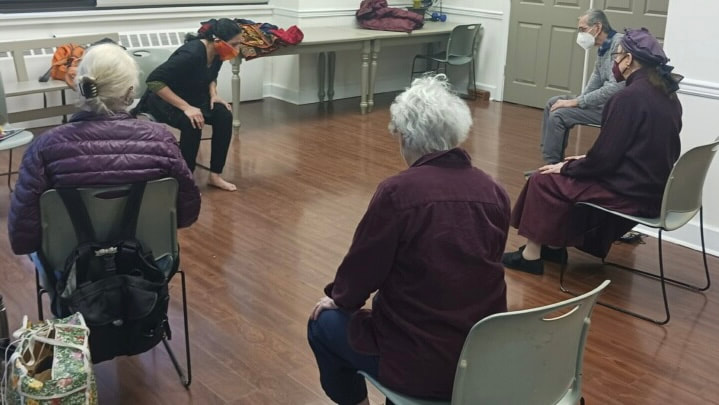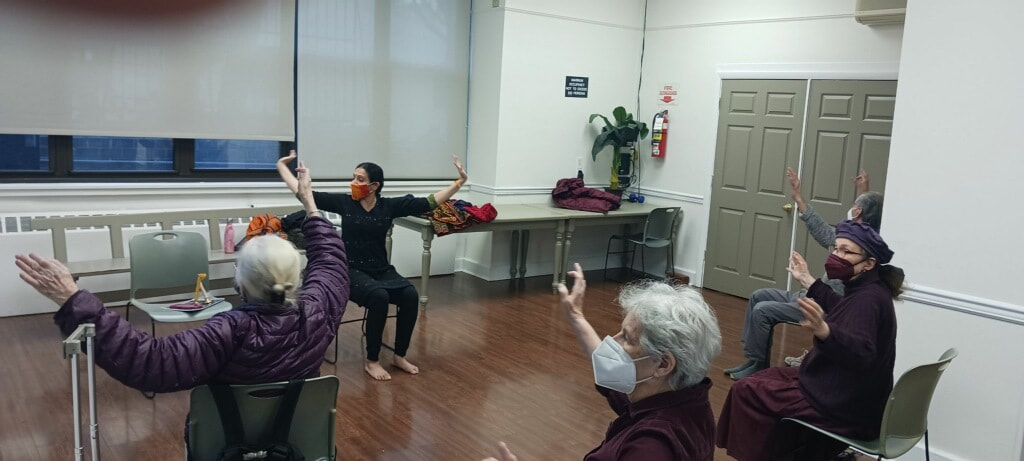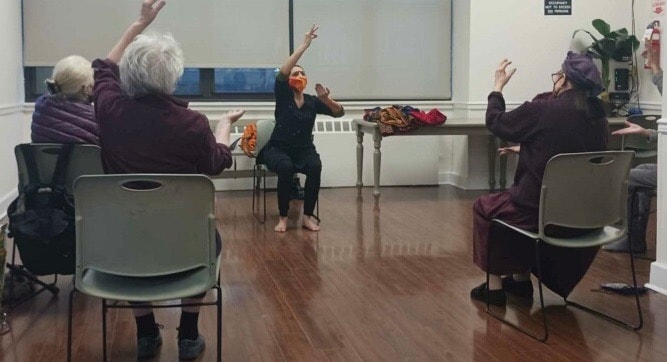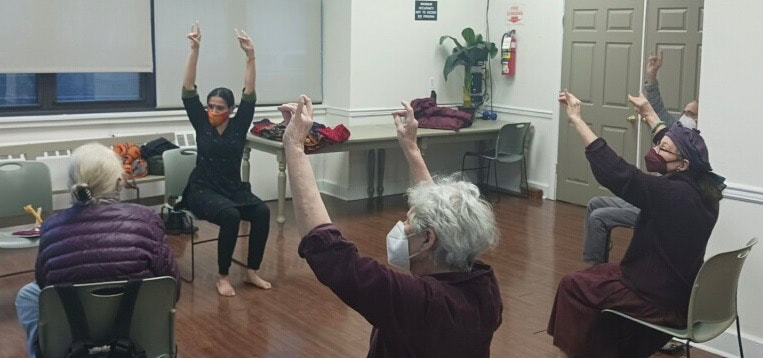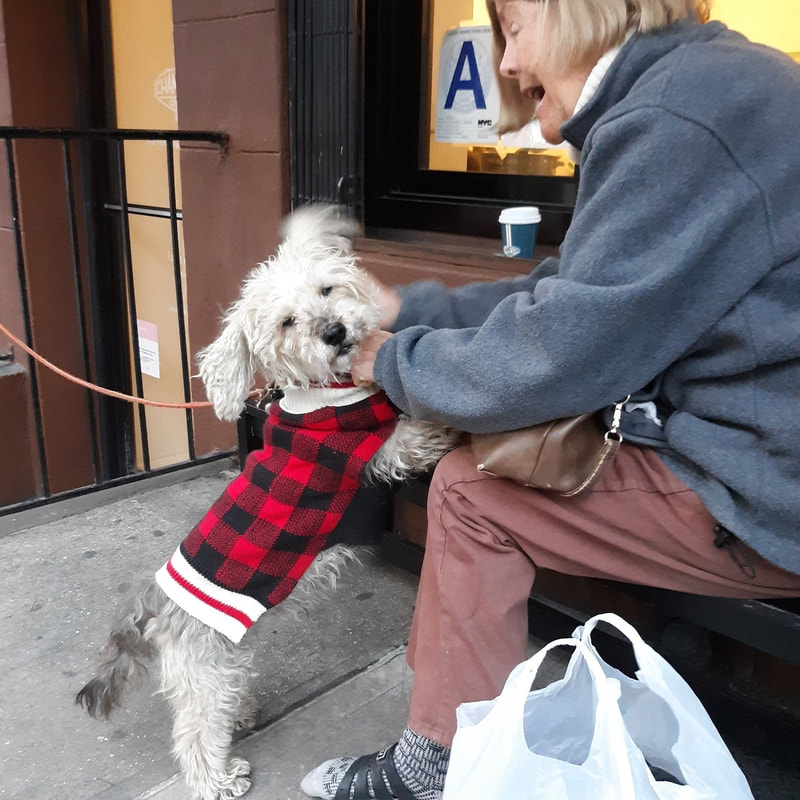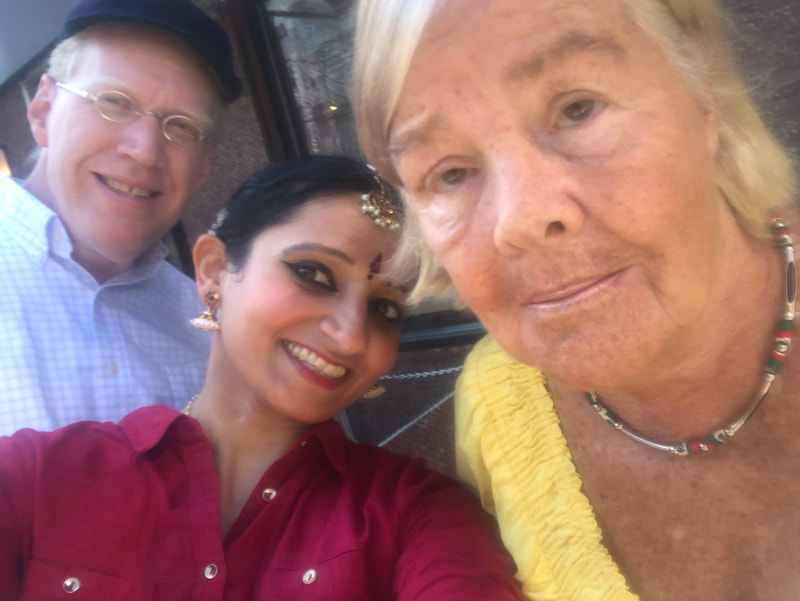Bharatanatyam as a form that engages multiple modalities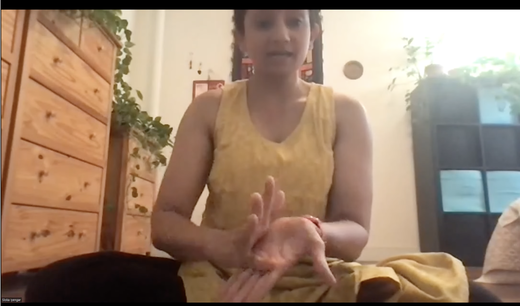 In addition to being an incredibly complex dance form, Bharatanatyam gives us an opportunity to engage with the dance, and by extension, with the world around us in a multitude of ways. In my sessions, participants learn how to keep talam (rhythm), sing, and chant in addition to the movements. We learn the rituals of the dance form, words and their meaning of songs or poems, and different interpretations. Through this, we learn to appreciate music, language, symbolism, philosophy, and later, the color and design of the stage and props, and the color and texture of costumes. By continuing my own learning as a lifelong process, I can bring the gift of these various skills to my participants in NYC and beyond. All gratitude is to my teachers – my gurus who have and continue to guide me in dance, music, and Sanskrit – for allowing and enabling me to see the detail and beatify in our traditional art forms and in our language. The image is a still from one of my sessions at India Home where I am so lucky to work with incredible seniors who are interested, engaged, and always want to learn and explore more!
1 Comment
Partnership with Encore Community ServicesStarting July 2023, I am proud to partner with Encore Community Services to bring Bharatanatyam to seniors in NYC. "Encore has provided seniors with a range of caring and quality services to help them live independent and dignified lives." Below is a video of what participants can expect in these sessions, the adaptations I will use, and the benefits to participants. Highlighting the universality of BharatanatyamAn effective way to participants in this rich form of learning is by highlighting the universality of Bharatanatyam.
Building on the universality of Bharatanatyam is imagery that includes animals and nature. In sessions with older adults, we typically come up with new hastas to describe animals, birds, and bugs around us. This sense of discovery is not only fun but also helps give participants autonomy and fosters creativity. It also helps us connect deeply with our local nature. Most importantly, it places Bharatanatyam not merely as a series of movements to learn, but as a form that fosters discovery due to (and not despite) the structure created! How could you show a squirrel?! Using the complexity inherent in Bharatanatyam for creative aging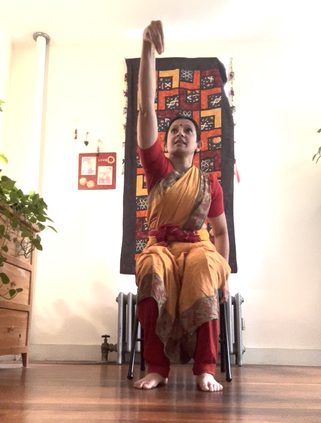 Bharatnatyam is an incredibly complex dance form! However, we can use this complexity to our advantage and to benefit our older adult populations. Layering skills ensure that all participants have something to work on, no matter if they are new to Bharatanatyam, or have been learning for a while. In this video, I show how we can layer skills using the imagery of elephants. Seated, in a count of four, we can sway from side to side evoking the stability and sure-footedness of elephants, and then, with the hasta “Arala”, we can show its ears. These movements also make effective use of our gaze. Next, we can use “Mukula” hasta to show the trunk of an elephant as it is trying to get a piece of fruit (above), or water (below). The effect of the trunk can be created with the entire arm or the hands. We can also emphasize that the impact of the trunk can be created with the eyes, which is just as beautiful and perhaps more nuanced as compared to the other options. Complexity and layering skillsIn previous Vichaar posts, we looked at the idea of complexity as it applies to science and dance. We talked about how the brain processes complex information and makes decisions in the face of uncertainty. We also looked at reductionism as one way by which scientists study complex things.
Bharatanatyam is ideal for older adults, as we can use this inherent complexity to our advantage! This means layering skills that participants can work on, no matter if they are new to Bharatanatyam, or have been learning for a while. In a group setting, layering skills also gives participants an opportunity to show and teach one another, which builds camaraderie and connections in the groups. In the next post, we will see an example of layering skills using the example of elephants. I chose elephants because of their stability, and because baby elephants bring up images of playfulness and fun! Bharatanatyam for all: the specificsBharatanatyam is a unique dance form that combines a multitude of aspects such as percussion, storytelling, narration, hand gestures, and facial expressions. How can we use these specific aspects of Bharatanatyam as tools for older adults to further express their own creativity? Bharatanatyam is so much more than exercise – it actively engages the body, mind, and spirit. How can we share this gift of Bharatanatyam, its depth and nuances, with our aging populations and enable a sense of accomplishment? The ideas I will present over the next few posts will talk about the specific ways in which I have tried to make Bharatanatyam adaptable and enjoyable to all, no matter their age or physical capabilities. We will look at how exactly we can go about layering skills, using the powers of observation and visualization, adapting movements to be done seated, and using our gaze effectively. In doing so, I get to honor my gurus and the countless hours they have spent on me and my dance practice and pass this lineage to others.
Enhancing balance in older adults through BharatantyamWe know that old age can be associated with falls, which many times, can be rather fatal. In fact, even falls that are short in duration can be deadly. Here, we can see my elder dancers at the YM&YWHA, Nagle Avenue demonstrating a slokam on Lord Shiva. After a few months of working together, they feel comfortable balancing on one foot!
Visualization in Bharatanatyam for creative agingBharatanatyam is comprised of a variety of components that are uniquely beneficial for creative aging. At the Goddard Riverside NORCs (Naturally Occurring Retirement Communities), I have had the privilege of working with older adults for the past several weeks. With this group, I wanted to work on a piece that was focused on visualizing different scenes. The piece I came up with is that of a dream – in this dream, we walk into a world where everything is clear and pristine, the colors are vivid, the air is fresh, and it has just stopped raining. The leaves are a shade of green that is clear and pure and the most vibrant green we have ever seen. As we enter this dreamscape, we observe everything around us, the flowers, leaves, creepers and vines, and worms. Since it has just rained, we can feel that the air is humid and we can still feel the last remaining raindrops. We see a pool of water in a clearing and describe the water that is gentle and serene. Over the course of the piece, we have different animals come in to get a drink of water. For a deer, we focused on its eyes and recreating its leaps with our eyes. We had a turtle which helped us think about stillness as a critical part of (any) dance. Participants shared their choices for animals as well, e.g., one dancer wanted her cat in this dream, and we were able to think of and recreate the movements of a cat with our shoulders. To do this, we first became cats, saw the squirrel that we were going to prey on, crouched, and did the telltale “stalk and pounce” movement of the cat. We practiced focusing our eyes on the prey and isolating our shoulder movements in a manner that is intentional and deliberate like a cat’s. Working on this piece seated gave participants the chance to think of and embody the different rhythmic patterns that different animals have, and to think about the different ideas we associate with particular animals e.g., elephants bring to mind the idea of stability, whereas rabbits evoke the feeling of jumps or bounces. Over the next several posts, I will show some specific examples of how we embodied the animals and this dream world. I will also talk about how observation and visualization are important for Bharatanatyam, and how practicing these skills might benefit everyone, but older adults in particular. Stay tuned! Picture credit: Janai at Goddard Riverside NORC
Bharatanatyam as a means of self-expression and immersion Many pieces in Bharatanatyam tell a story through mudras, melody (“raga”), and rasas. With one group of dancers at the Goddard Riverside Naturally Occurring Retirement Community (NORC), we are co-choreographing a piece that portrays different animals through rhythm, movement, eyes, and facial expressions. In this piece, we are seeing animals in their most vivid forms as we are dreaming. We first show the animals, and then through the immersive qualities of Bharatanatyam eventually “become” these animals. Participants often talk about “words not being enough” to describe their feelings, but Bharatanatyam offers additional avenues to make sense of the world around us. Anecdotally, dancers who are caregivers for their partners mention how it is “impossible to think of anything else while doing Bharatanatyam” and it is this deep immersion that participants find challenging and fulfilling. Photo credit: Janai
Remembering Carol Schachter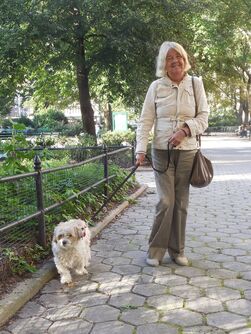 This is the first post on my site potentially riddled with grammatical and punctuation errors, the first post that Carol will not see and comment on right away. I lost my closest friend Carol Schachter on December 19, 2022. I first met Carol at Bowery Residential Committee (BRC), its “glass factory” building in NYC on Thanksgiving of 2010. Having just arrived in NYC from South Carolina, I knew no one in the city I was about to call home. I had just finished my doctoral work at the USC School of Medicine and came to NYC for my postdoctoral work in epilepsy. I had the feeling that my career was just about to begin, though I did not know how or what shape it would take. I also knew I would love the city, I just didn’t know how much. And looking back, I realize I was given the gift of having been introduced to NYC by Carol. Our adventures took us to Dag Hammarskjöld Plaza; Van Cortland Park, where we had sandwiches next to a tombstone; the opera where we saw, among other things, Amal and the Night Visitors; the Bastille Day parade with its macaroons; and the tramway to Roosevelt Island. Our love of books, words, pancakes at Tivoli, pizza at Posto’s, and for the city which can be absurd and ridiculous at times brought us closer. She loved her neighborhood of Gramercy Park and took care of it through its various organizations; she loved the small lending library, the sculptures and the home she and Jon shared for decades. I knew Carol for 12 years, and in that time, I came to rely on her as a thought partner, editor, proofreader and organizer. Incredibly patient and extraordinarily quick, she would comment on commas, semicolons and errant spaces in my writing as efficiently as she would on issues of overall organization, consistency, and scientific rigor. In fact, every word on my website has been seen, edited, and commented by her. When I would send her videos to watch, she would make it a point to turn on close captioning and proofread every single word so that I was offering accessible content to all. Her faith and love of my work and my words gave me confidence when times were bleak and grey. She took words seriously, and she took work seriously without ever being grim or aloof. Her love for her community, her people, the senior dogs she rescued, the dogs she placed, and her patience, and even enjoyment of all kinds of people stand out in my mind. The first one to show up for my performances, the first one to register for my lectures, demonstrations and webinars, she would have constructive feedback after all of my events, no matter how big or how small. COVID was harsh to many of us, but more so to our senior citizen neighbors. Carol made me realize how unkind our city can be to its seniors, which was especially the case during the pandemic. From subway elevators that do not work, to sidewalks that are iced over after a snowstorm, Carol opened my eyes to the many things I took for granted as far as accessibility. She was adamant about changing the treatment of seniors in our society and a big supporter of my creative aging work. In fact, the ideas, structure, and the sentiment behind my creative aging efforts is all thanks to Carol. She would remark on how widows in our society are part of a magic trick; considered "old" and without a man next to them, they suddenly become invisible. There is no ending to an article like this. Although Carol’s physical life has ended, her mind, her humor, wit, quickness, and lightness of spirit will stay with me and her other friends for as long as we live. Her work ethic and gentleness, I hope to carry on and pass on. |
AuthorMy name is Sloka. I am a neuroscientist and dancer; you can find more about me here. Archives
June 2024
|
